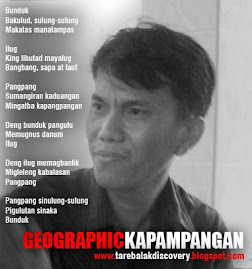Angeles City
By Joel Pabustan Mallari and Robby Tantingco
In 1796, when founder Don Angel Pantaleon de Miranda cleared a wooded area called Culiat to make way for a new settlement, he chose the spot near a creek that would later be known as Sapang Balen.
Sapang Balen is actually Taug River, which originates in barrio Cuayan and is an offshoot of Ebus River, an upland creek that emanates from the foothills of Mount Pinatubo and joins Abacan River near barrio Anunas. As Taug River nears the town proper, it assumes the generic name of Sapang Balen. According to historian Mariano A. Henson, Taug River/Sapang Balen regularly inundated the town of Angeles, until its headwaters gradually dried up and Taug River disappeared, leaving behind only the downstream Sapang Balen, which today begins as a spring in the grassy area between Carmenville Subdivision, Enclave and Cuayan. In the cataclysmic rearrangement of the landscape following the 1991 eruption of Mount Pinatubo, Taug River reappeared, wreaking havoc on the town proper of Angeles, like it had done so many times in the past. Today it has disappeared once again, and houses and subdivisions have sprouted in its wake.
Kabalasan (or Mabalas) River is the name given to Sapang Balen as it leaves Angeles City and proceeds to San Fernando. It joins Sapa Calulut River and Sindalan River before losing much of its water and becomes Maimpis River. It is called Kabalasan River because the river turns sandy at this point, or mabalas in Kapampangan. The current of these various rivers and creeks “bends and slows down” halfway through Barrio Sindalan, thus gaining a meandering shape— marked by old townfolks as sinandal. The water of these rivers and creeks continues to deccelerate, thin out, and turn shallow, thus becoming meímpis. This spot is what is known today as Barrio Maimpis.





1811
Don Angel puts up his first house “on the northwest corner of the intersection of Sapang Balen creek and the road to Porac” (present Robin Theatre).
1850
Town population: 4,452. Number of houses: 742. Nipa palms (sasa) are still abundant in Angeles, especially along Sapang Balen in Mangga and Pulung Bulu.
1851
Townspeople build the first concerete bridge over Sapang Balen. Called Santo Rosario Bridge, it is located on the present Plaridel Street.
1854
The second concrete bridge, the Santo Angel Bridge, is built. It is located on Sto. Entierro Street, in front of the church.
1859
The third concrete bridge, the San Jose Bridge, is built . It is located near the Bale Herencia.
1881
Taug River overflows and destroys all three bridges on Sapang Balen, including several houses in barrio San Jose. Its floodwaters reaches as far as the present Villa Teresa Subdivision.
1885
Taug River again overflows into the Sapang Balen and finishes off the three bridges.
1912
Don Jose P. Henson (Mariano’s father) builds a levee to prevent the converging streams Sapang Bayu and Sapang Ebus from flowing into Sapang Balen.
1919
Patangue River and Taug River between barrios Cuayan and Pampang swell and wash away bridges in town
1972
Sapang Balen and Abacan River wreak havoc in Angeles during the monsoon season; dozens of houses in Pulung Bulu and San Jose are washed away.
1991
On June 15, Typhoon Yunya crosses Angeles at the same time that Mount Pinatubo erupts. As a result, a mixture of water, ash and mud from the slopes of the volcano flows in quantities more than the Abacan river channel can take, destroying all the bridges in its path. In downtown Angeles, the Sapang Balen also overflows its banks. Residents evacuate en masse. US servicemen and their families have also evacuated earlier.
1994
In August, the Pasig Potrero River nearly overtops Delta 5 Watchpoint, the area where it is nearest to Sapang Balen.
2003
Mayor Carmelo F. Lazatin and the Environmental Management Bureau of Department of Environment and Natural Resources (EMB-DENR) initiate a sustainable program in maintaining the cleanliness of waterways in the city. A memorandum of agreement (MOA) is signed affirming the respective tasks of various sectors in eliminating or minimizing pollution of water flowing through the Sapang Balen River.
Holy Angel University (HAU), represented by President Bernadette M. Nepomuceno, commits to conduct continuous community public education information drives for the sustainability of the project and to participate in actual monitoring. The barangay councils of San Jose represented by barangay chairman Benito Tiatco; Sto. Rosario, headed by barangay chairman Jose "Jiji" Paras Jr.; and Pulung Bulo, headed by barangay chairperson Gloria S. Tanhueco, also pledge support.
2009
In May, Bishop Pablo Virgilio David leads hundreds of volunteers and supporters in a river clean-up drive. Organized by the Social Action Center, “Sagip Sapang Balen” aims to raise consciousness especially among riverbanks residents and inspire in them a sense of personal responsibility for the cleanliness of the river.
2010
On March 13, Sagip Sapang Balen Concert with Noel Cabangon as guest is held at the HAU Chapel of the Holy Guardian Angel Piazza. Sponsored by the Social Action Center, the concert also features poetry reading and mural and painting exhibits.


No comments:
Post a Comment